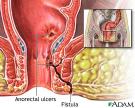
Digestion & Digestive Health - Anorectal Fistula
Anorectal Fistula
An anorectal fistula is an abnormal channel that leads from the anus or rectum usually to the skin near the anus but occasionally to another organ, such as the vagina.
- Anorectal fistulas are common among people who have an anorectal abscess, Crohn's disease, or tuberculosis.
- Anorectal fistulas can cause pain and produce pus.
- The diagnosis is based on an examination and other viewing techniques.
- Treatment may involve surgery, but some nonsurgical alternatives now exist.
Anorectal abscess is a localized collection of pus due to inflammation of the soft tissue near the rectum or anus. Inflammation may produce an anal fistula — an abnormal opening in the anal skin — that may communicate with the rectum.
The inflammatory process that leads to abscess may begin with an abrasion or tear in the lining of the anal canal, rectum, or perianal skin and subsequent infection by Escherichia coli, staphylococci, or streptococci. Trauma may result from injections for treatment of internal hemorrhoids, enema-tip abrasions, puncture wounds from ingested eggshells or fish bones, or insertion of foreign objects. Other preexisting lesions include infected anal fissure, infections from the anal crypt through the anal gland, ruptured anal hematoma, prolapsed thrombosed internal hemorrhoids, and septic lesions in the pelvis, such as acute appendicitis, acute salpingitis, and diverticulitis. Systemic illnesses that may cause abscesses include ulcerative colitis and Crohn’s disease. However, many abscesses develop without preexisting lesions. 
As the abscess produces more pus, a fistula may form in the soft tissue beneath the muscle fibers of the sphincters (especially the external sphincter), usually extending into the perianal skin. The internal (primary) opening of the abscess or fistula is usually near the anal glands and crypts; the external (secondary) opening, in the perianal skin.
An infected fistula may be painful and may discharge pus. A doctor can usually see one or more openings of a fistula or can feel the fistula beneath the surface. A probe may be inserted to determine its depth and direction. Looking through an anoscope inserted into the rectum and exploring with the probe, a doctor may locate the internal opening. Inspection with a sigmoidoscope, which is a much longer viewing scope, helps a doctor determine whether the problem is being caused by cancer, Crohn's disease, or another disorder.
Previously, the only effective treatment was surgery to open the fistula (fistulotomy). During surgery, sometimes the sphincter is partially cut. If too much of the sphincter is cut, the person may have difficulty controlling bowel movements. Newer surgical procedures use advancement flaps (flaps are stretched over the opening of the fistula). Biologic plugs and fibrin glue instillations are alternatives to surgery.
If the person has diarrhea or Crohn's disease, which may delay wound healing, surgery usually is not performed. Drug treatment for Crohn's disease can help a fistula close.